History - Class 10
Our Past - I
Chapter 4: The Age of Industrialisation
Activity: 1
Question: Give two examples where modern development that is associated with progress has led to problems. You may like to think of areas related to environmental issues, nuclear weapons or disease.
Answer:
- Development in Agriculture:Hybrid seeds, urea and chemical manure have led to the problem of soil sterility, more consumption of water and environmental problems.
- Development in Nuclear Weapons: Modern nuclear weapons are the most destructive because of the radioactive pollution that they spread. Due to this many people die, and many get injured for their whole lives.
Activity: 2
Question: The way in which historians focus on industrialization rather than on small workshops is a good example of how what we believe today about the past is influenced by what historians choose to notice and what they ignore. Note down one event or aspect of your own life which adults such as your parents or teachers may think is unimportant, but which you believe to be important.
Answer: The way in which historians focus on industrialization rather than on small workshops is a good example of how what we believe today about the past is influenced by what historians choose to notice and what they ignore. Note down one event or aspect of your own life which adults such as your parents or teachers may think is unimportant, but which you believe to be important.
Activity: 3
Question: Look at Figs. 4 and 5. Can you see any difference in the way the two images show industrialization? Explain your view briefly
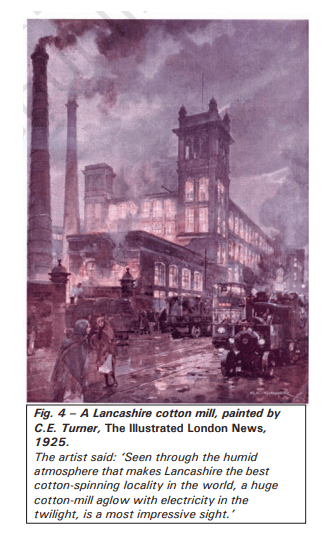
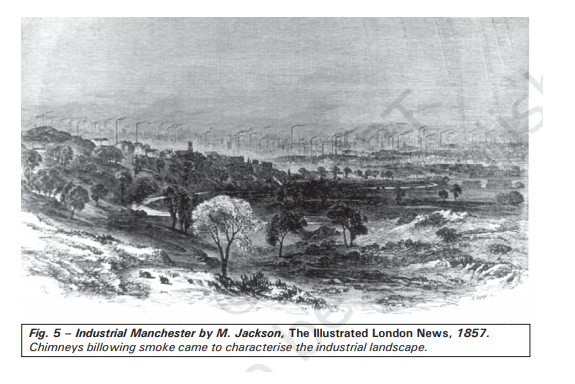
Answer:
- In figure 4 the Lancashire cotton mill, adds to the beauty of the city due to its lighting system during the evening.
- In figure 5 the Manchester is shown to have a cluster of industries that emit lot of smoke. It symbioses environmental pollution.
Activity: 4
Question: Imagine that you are a merchant writing back to a salesman who has been trying to persuade you to buy a new machine. Explain in your letter what you have heard and why you do not wish to invest in the new technology
Answer: Due to under-written reasons that I have gathered on my own experiences, I don’t want to invest in the new technology:
- It is costly ineffective, not easy to repair and it breaks down frequently.
- I would prefer to pay low wages to cheap labor rather than buy a costly new machine.
- Machines produce standard and uniform goods, while customers ask for variety, range color, specifically designed handmade goods.
Discuss:
Question: Look at Figs. 3, 7 and 11, then reread source B. Explain why many workers were opposed to the use of the Spinning Jenny.
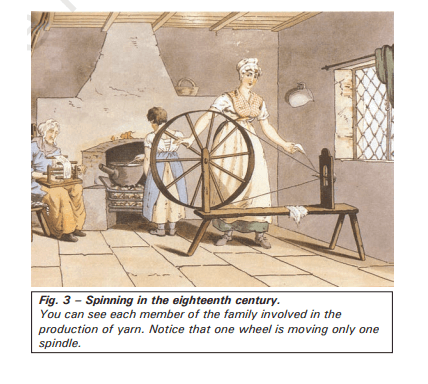
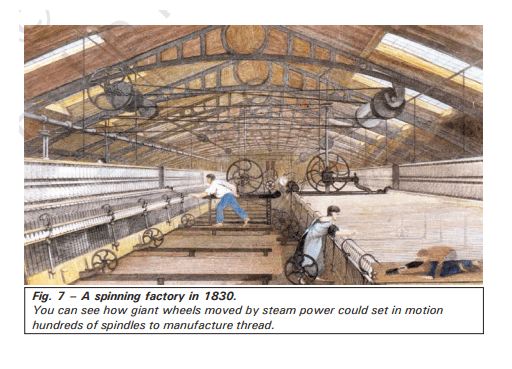
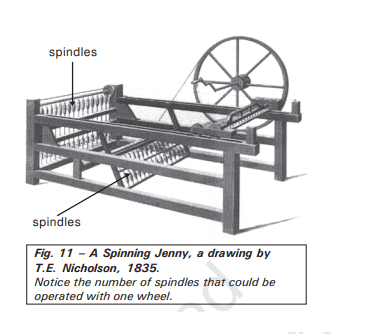
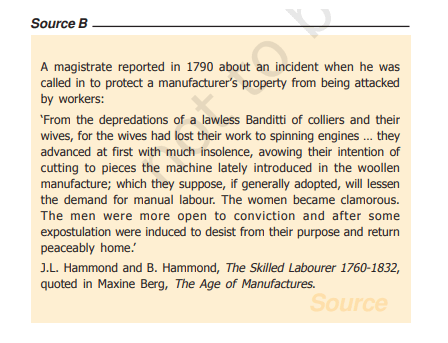
Answer:
- Spinning Jenny was the machine that made it possible to yarn many spindles from one wheel.
- Whereas earlier one wheel could yarn only one spindle. At that time all members of a family were employed, and earned.
- But due to Spinning Jenny Productivity increased, as many spindles could be yearned at one time from one wheel.
- This led to increase in unemployment.
Activity: 5
Question: On a map of Asia, find and draw the sea and land links of the textile trade from India to Central Asia, West Asia and Southeast Asia.
Answer:
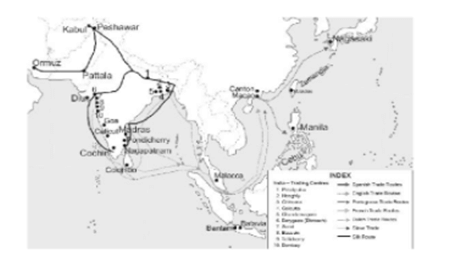
Write in brief
Question 1. Explain the following:
- Women workers in Britain attacked the Spinning Jenny.
- In the seventeenth century, merchants from towns in Europe began employing peasants and artisans within the villages.
- The port of Surat declined by the end of the eighteenth century.
- The East India Company appointed Gomasthas to supervise weavers in India.
Answer:
- Women workers in Britain attacked the Spinning Jenny.
The Spinning Jenny was invented by James Hargreaves in 1764. This machine speeded up the spinning process and reduced labor demands. By the use of this machine, a single worker could make a number of spindles, and spin several threads at n time. It simply meant that as a result of this machine, many weavers would be left without any job and became unemployed. It was this lea: of unemployment which —ace women workers, who survived on hand -spinning began attacking the new machines.
- In the seventeenth century, merchants from towns in Europe began employing peasants and artisans within the villages.
The earlier phase of industrialization in rich large scale production was carried out for the international market not at factories but in decentralized units.
- Huge demand:The world trade expanded at a very fast rate during the 17th and 18th centuries. The acquisition of colonies was also responsible for the increase in demand. The town producers failed to produce the required quantity.
- Powerful town producers:
- The town producers were very powerful,
- The producers could not expand the production a: will. This was because in the towns, urban crafts and trade guilds were powerful. These were associations of producers that trained craftspeople, maintained control over production, regulated competition and prices, and restricted the entry of new people within the trade.
- Monopoly rights:The rulers granted different guilds the monopoly right to produce and trade in specific products It was therefore difficult for new merchants to set up business in towns. So they turned to the countryside.
- New economic situation in the countryside:Open fields were disappearing in the countryside and the commons were being enclosed. Cottagers and poor peasants who were earlier depended on common lands became jobless So when merchants came around and offered advances to produce, peasants households eagerly agreed.
- The port of Surat declined by the end of the eighteenth century.
- Most of the European companies had huge resources, so it was very difficult for the Indian merchants and traders to face the competition.
- The European companies were gaining power by securing a variety of concessions from the local courts.
- Some of the companies got the monopoly rights to Dade.
All this resulted in the decline of the old ports of Surat and Hoogly through which local merchants had operand. Exports from these ports fell dramatically. The credit that had financed the earlier trade began drying up. and the local bankers slowly went bankrupt. - In the last years of the seventeenth century, the gross value of -race that passed through Sura: had been t 16 million. By the 1740’s. It had slumped to 3 million rupees.
- With the passage of time. Surat and Hoogly decayed. Bombay (Mumbai) and Calcutta (Kolkata) grew.
- The East India Company appointed Gomasthas to supervise weavers in India.
- Monopoly right: Once the East India Company established political power, it asserted a monopoly right to trade.
- New system: After establishing monopoly over trade it proceeded to develop a system of management and control that would eliminate competition, control costs, and ensure regular supplies of cotton and silk goods. This it did through a series of steps.
- Appointing Gomasthas: The Company tried to eliminate the existing traders and brokers connected with the doth trade, and establish a more direct control over the weavers. It appointed a paid secant called the Gomostha to supervise weavers, collect supplies, and examine the quality of cloth.
- System of advances: To have a direct control over the weavers, the company- started the system of advances. Once an order was placed, the weavers were given loans to purchase the raw material for their production. Those, who took loans had to hand over the doth they produced to the Gomastha. They could not take it to any other trader.
- Use of power: The places where the weaver refused to co-operate the Company used its police. At many places, weaver was often beaten and flogged for delays in supply.
Question 2. Write True or False against each statement:
- At the end of the nineteenth century, 80 percent of the total workforce in Europe was employed in the technologically advanced industrial sector.
- The international market for fine textiles was dominated by India till the eighteenth century.
- The American Civil War resulted in the reduction of cotton exports from India.
- The introduction of the fly shuttle enabled handloom workers to improve their productivity.
Answer:
- False
- True
- False
- True
Question 3. Explain what is meant by proto-industrialization.
Answer: The partly phase of industrialization in which large-scale production was carried out for the international market not at factories but in decentralized units.
Discuss
Question 1. Why did some industrialists in nineteenth century in Europe prefer hand labor over machines?
Answer:
- New technology was expensive and industrialists were cautious about using it.
- Machines often broke down and repair was costly.
- There was no shortage of human labor as poor peasants and workers moved to the cities in large numbers in search of work. Wages were low.
- In seasonal industries where production fluctuated with season, industrialists usually preferred hand labor, employing workers for the season.
- There was demand for goods with intricate designs and specific shapes. This required human skill, not mechanical technology.
Question 2. How did the East India Company procure regular supplies of cotton and silk textiles from Indian weavers?
Answer:
- The East India Company establish had direct control over cotton textile industry by eliminating the existing traders and brokers connected with the cloth trade and appointing a paid servant called the ‘gomastha’ for supervision of weavers, collecting supplies and examining the quality of cloth.
- The Company prevented its weavers from dealing with other buyers by giving them advances or loans for purchasing the raw material for their production.
- As loans flowed in and the demand for fine textiles expanded, weavers eagerly took the advances and started producing cloth for the Company. Thus, the East India Company eliminated competition, controlled costs and ensured regular supplies of cotton goods.
Question 3. Imagine that you have been asked to write an article for an Encyclopaedia on Britain and the history of cotton. Write your piece using information from the entire chapter.
Answer: Britain and the History of Cotton During the seventeenth and eighteenth centuries, merchants would trade with rural people in textile production. A clothier would buy wool from a wool stapler, carry it to the spinners, and then, take the yarn to the weavers, fuller and dyers for further levels of production. London was the finishing centre for these goods. This phase in British manufacturing history is known as proto-industrialization.
In this phase, cotton was the leading sector in the first stage of industrialization. Most inventions in the textile production sector were met with disregard and hatred by the workers because machines implied less hand labor and lower employment needs. The Spinning Jenny was one such invention. Women in the woolen-industry opposed and sought to destroy it because it was taking over their place in the labour market.
Before such technological advancements, Britain imported silk and cotton goods from industry in India to its full potential, often by force, for the benefit of Britain. Later, Manchester became the hub of cotton production. Subsequently, India was turned into the major buyer of British cotton goods. During the First World War, British factories were too busy providing for war needs. Hence, demand for Indian textiles rose once again. The history of cotton in Britain is replete with such fluctuations of demand and supply.Question 4. Why did industrial production in India increase during the First World War?
Answer:
- Manchester imports into India declined as British mills were busy with war production to meet the needs of army. Suddenly, Indian mills had a vast home market to supply.
- Due to prolongation of the war Indian factories were called upon to supply war needs like jute bags, cloth for army uniforms, tents and leather boots, horse and mule saddles, etc.
- New factories were set up and old ones ran in shifts to increase their production.
- Many new workers were employed and everyone was made to work longer hours.
Project
Question: Select any one industry in your region and find out its history. How has the technology changed? Where do the workers come from? How are the products advertised and marketed? Try and talk to the employers and some workers to get their views about the industry’s history.
Answer: Cotton textile in Ahmedabad, Gujarat:
- Cotton textiles are among the oldest industries of Ahmedabad, Gujarat. One can trace it back to the day of Indus Civilization when cotton fabrics from Lothal (port) were sent to different parts of Asia.
- Initially, old technology was followed by the weavers. The spinning wheel constituted its sole machine. Ladies of the village used to spin the cotton. During the British period, technology changed and several cotton textile mills were set-up in different parts of the country. Powerloom was used in place of handloom. Factories were opened for twenty-four hours. Several types of machines were used. Machines of advanced technologies invented in England and other countries.
- The workers for cotton textile mills used to come from rural areas of Gujarat and Maharashtra. Some of them used to come daily by cycles and most of them settled nearby the factory. Slums developed and they created several types of problems for the city dwellers.
- The industry provided living to Farmers, cotton ball pluckers and workers engaged in ginning, spinning, weaving, dying, designing, packaging, sewing and tailoring.The products were advertised by the agents of mills under the British East India Company and local merchants and traders. The European traders used to buy fine quality of cotton textile from Ahmedabad and that was taken to Surat.
- We have talked with employers and some workers of the cotton textile. Employers said that they used to face tough competition with the British cotton textile before the independence but after India's independence, they could receive certain incentives. The globalization since 1990s have however, opened the way for “Wealth is Right” in the form of MNCs. Countries in Europe were also installed.